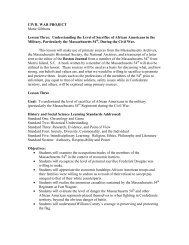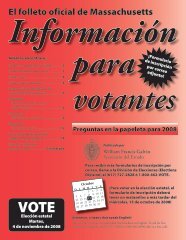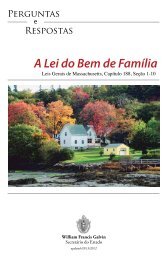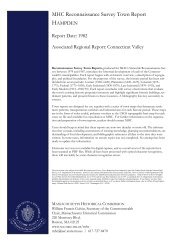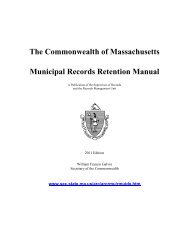Roads, Rails, and Trails - Secretary of the Commonwealth
Roads, Rails, and Trails - Secretary of the Commonwealth
Roads, Rails, and Trails - Secretary of the Commonwealth
Create successful ePaper yourself
Turn your PDF publications into a flip-book with our unique Google optimized e-Paper software.
This plan shows foundations, stone fences, two wells, <strong>and</strong><br />
<strong>the</strong> places where <strong>the</strong> archaeologists dug.<br />
50<br />
historical narrative. What a difference from <strong>the</strong> Sampson’s<br />
Tavern site, with its many building foundations, features, <strong>and</strong><br />
artifacts, <strong>and</strong> its abundantly documented existence.<br />
This is an example <strong>of</strong> how archaeology is a science. It<br />
is a way <strong>of</strong> testing hypo<strong>the</strong>ses: ideas about what went on in <strong>the</strong><br />
past. In this case, <strong>the</strong> hypo<strong>the</strong>sis, based on written history, was<br />
that <strong>the</strong>re was a tavern here. Archaeological digging is a kind<br />
<strong>of</strong> science experiment—a way <strong>of</strong> getting independent evidence<br />
to test that hypo<strong>the</strong>sis—<strong>and</strong> in this case finding no evidence to<br />
support it. At <strong>the</strong> same time, <strong>the</strong> lack <strong>of</strong> evidence did not<br />
disprove <strong>the</strong> hypo<strong>the</strong>sis. While it may be disappointing to find<br />
no evidence to support a beloved local story, <strong>the</strong> upside is that<br />
it suggests new questions. For example, was <strong>the</strong>re a Kingsley<br />
Tavern somewhere else in town or in a nearby area that was<br />
mislocated by ei<strong>the</strong>r Caswell or her sources? Was <strong>the</strong> tavern<br />
located at a distance from <strong>the</strong> road so that it was outside <strong>the</strong><br />
area that was tested? This seems unlikely as it would be bad<br />
business for a tavern to be too far from <strong>the</strong> road, especially in<br />
<strong>the</strong> days when traffic was less noisy <strong>and</strong> dangerous. Perhaps<br />
<strong>the</strong> Kingsley Tavern, which only existed for 26 years<br />
(compared to <strong>the</strong> nearly 100-year lifespan <strong>of</strong> Sampson’s<br />
Tavern) was a small, informal place, that did not leave a great<br />
deal <strong>of</strong> material behind, <strong>and</strong> whose traces were obliterated by<br />
later occupations. Were <strong>the</strong>re any o<strong>the</strong>r taverns along Route 32,<br />
or in o<strong>the</strong>r parts <strong>of</strong> town? Where did thirsty Royalston residents<br />
go to get a drink in <strong>the</strong> early 1800s? In archaeology as in<br />
science in general, an experiment <strong>of</strong>ten raises more questions<br />
than it answers.



